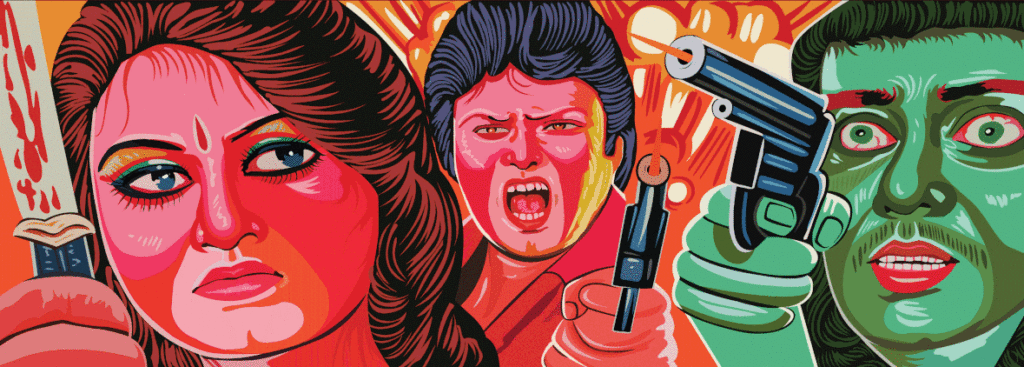
Bangladeshi film industry: Alive and Transient

Mahabubul Antor
A misconception that exists among people is that the Bangladeshi film industry is a young entity. While that maybe true, if one is technical about the timeline, the truth is Bangladeshi people stepped into the world of filmmaking as early as 1919 when the region was still under British rule. The very well-known industry, commonly known as Dhallywood came into being somewhere around 1956. Bangladesh was not born yet and was known to the world as East Pakistan.
Dhallywood began its journey with Abdul Jabbar Khan’s ‘Mukh O Mukhosh’ (The Face and The Mask, 1956) — the first Bengali language film made in East Pakistan. The film had been in the making since 1953 and had been delayed due to lack of resources. Despite the limited resources, the film was a great success and the audience rushed to the hall to enjoy and absorb the very first cinema made in that region.
Bangabandhu Sheikh Mujibur Rahman introduced the ‘The East Pakistan Film Development Corporation Bill 1957’ after the stellar success of ‘Mukh O Mukhosh.’ Initially, the corporation only allowed specific directors like Fateh Lohani, A.J. Kardar to make films. Their movies like Asiya, Akash Ar Mati (The Sky and the Earth), and The Day Shall Dawn changed the whole East Pakistan film industry. The Day Shall Dawn was submitted as a Pakistani entry for the 32nd Academy Awards and 1st Moscow International Film Festival where it won a gold medal.
The establishment of the East Pakistan Film Development Corporation aided greatly to the growth of the East Bengal Film Industry and helped raise the three prominent film studios in Dhaka. The 1960s was a golden era for the film industry. The years ahead saw many notable filmmakers working with the corporation to produce iconic movies such as Matir Pahar (The Clay Hill) and E Desh Tomar Amar. During that time, the industry churned out around 20-35 films a year with star directors such as Khan Ataur Rahman, Salahuddin, and Zahir Raihan.
Many prominent actors such as Abdur Razzak, Farooque, Kabori Sarwar, Shabana, Farida Akhter Bobita, and many others made their debut during that era. The late sixties saw the industry flourish with quality films such as Julekha (1967), Nawab Sirajuddaula (1967), and Jibon Theke Neya (1970).

The industry experienced a major shift in the themes during the late sixties and whole of seventies. The Bengali directors made films focused on the Language Movement, political movements and the 1971 Liberation War. The Dhaka film industry produced the highest number of films since 1956 in the year 1970 when East Pakistan was at the heart of political turmoil. However, the output dropped drastically in 1971 when only six movies were released and that too before the Liberation War.
The nine-month war took many filmmakers to the battlefield to join the Muktibahini. Many fled to India as refugees. One such prominent director was Zahir Raihan, who escaped to the neighbouring country at the face of Pakistani army’s persecution of intellectuals. Raihan fought the war differently, putting his genius at work. He produced the documentary ‘Stop Genocide’, which painted a clear picture of the sufferings of the Bengali refugees and the brutal actions of the Pakistani army.
The 20-minute documentary was circulated throughout the whole world with the help of then Indian Prime Minister Indira Gandhi. It helped Bangladesh get recognition as a free country and collect funding for the war and refugees. ‘Stop Genocide’ in itself was a new milestone for Bangladeshi cinema, which showcased a new style of documentaries. It stood out due to Zahir Raihan’s use of symbolism and unique approach to storytelling. The narrative made it seem like the filmmaker himself was telling the Pakistani soldiers to stop the massacre in Bangladesh.
After the liberation war, the East Pakistan Film Development Corporation changed its name to Bangladesh Film Development Corporation (BFDC). After the new coining, some rules were changed such as anyone could make a movie rather than only specific directors. This prompted many aspiring directors to make their dreams a reality and make movies most of which were based on the war of 1971. The 1970s saw some of the most extraordinary movies in Bangladesh’s cinematic history. ‘Titas Ekti Nodir Naam’, ‘Golapi Ekhon Traine’, ‘Shongram’, ‘Ora Egaro Jon’ and other notable films, forever changed the film industry.
In 1975, the Bangladesh government introduced the national film award and donation for creative movies. During that time, the masses had a rich taste in cinema and filmmakers were catering to the demands with both commercial and critically acclaimed films.
It was during the 1980s, Indian movies started influencing our commercial films. Fight scenes between the hero and 10 villains, a dance number in the middle of the road or a brutal villain trying to hamper the hero’s family, became common tropes. The adaptation from Hindi cinemas was slowly wiping out the Bengali culture from the industry. It was during the same period, Bangladesh got its most famous and commercially acclaimed actor Abdur Razzak. Even though he had been working in films from the 70s, it was during this time he became “Nayak Raj” Razzak. During the same decade, his contemporaries Iliyas Kanchan, Jashim, Diti, Rozina, and many more gleaned popularity.
Despite the infiltration of adapted films in the industry, there were some directors who were making outstanding movies that were both original and immensely populat. ‘Bhat De’, ‘Shuvoda’, ‘Chutir Ghanta’, ‘Devdas’ were movies that created history. These movies showed the industry that originality can be beautiful, and portraying people’s stories is better than showing adapted false stories.
The ‘Parallel Cinema Movement’ also started in this era, which was brought on by Alamgir Kabir. The influence of Hindi cinema was slowly poisoning Bangladeshi culture and due to the adapted stories, the entire concept of originality was on the verge of disappearing. With the movement, Alamgir Kabir tried to prove that realistic or naturalistic movies were far more important and superior than adapted movies. Some intellectual directors like Tanvir Mokammel, Tareque Masud, and Morshedul Islam who were part of the movement started making realistic and naturalistic cinemas. All of them were part of the Bangladesh Short Film Forum, an organization of young filmmakers, noted for organizing international short and independent film festivals in Bangladesh. They also arranged different types of seminars, workshops, and discussion sessions of movies, along with screenings in their film center.

The 1990s and 2000s, were dominated by mainstream commercial movies. The use of abusive language, vulgarity, and copied stories from Hindi movies was still dominating the Bangladeshi film industry. In his documentary ‘Swarup Sondhan,’ director, Mohiuddin Faruque said, “Instead of saving tradition, a trend of mimicking started. In the mid-1990s and 2000s, most of the movies were copied from Mumbai.” He did not use the word inspired because a quick look at the movies from that era we show that Bangladeshi directors have copied every single frame of the original one. In my opinion, cinema is an art, and art cannot or should not be imitated.
There were many directors who tried to justify the use of vulgarity and abusive language by comparing with foreign movies. Renowned film director Kazi Hayat said in an interview – “In European movies, you hear abusive language all the time, why don’t you call it obscene? In Bangla when a rickshaw puller is abusing someone, why would you call it obscene?” Directors like Kazi Hayat believed that in order to make the characters believable, use if this sort of language is a must. These times were possibly one of the darkest in the history of Bangladesh’s film history.
Shortage of original stories, low budget, vulgarity, and less audience nearly took the industry to the ground. Almost every director of the industry was making low-quality movies that basically told stories and showcased obscenity. Filmmakers such as Tauquir Ahmed and Humayun Ahmed were few of those still making quality movies such as ‘Joy-Jatra, ‘Aguner Poroshmoni’, ‘Shyamol Chhaya.’ Despite that, the industry became extremely unstable with no help from the government and cinema halls getting closed due to a lack of good movies. At the end of the 2000s, some movies brought a breath of fresh air and were able to bring back audiences to the cinema halls. ‘Monpura’ by Giasuddin Selim was one of those movies, the simple story touching everyone’s hearts. However, the situation improved in 2006-07 when with the help of the Bangladeshi government and new large production companies, the industry saw a rise again.

One of the reasons for the industry to still lag behind in comparison to neighbouring country is that Bangladeshi filmmakers are quite adverse to using modern technologies for their production. Although there is no logical explanation for the reluctance, some directors blame the budget system and the expense of gears. Bangladeshi films are still using archaic movie kits in a time of DSLR kits. Many directors argue that DSLR movie kits are for advertisements only or for students to make short films.
However, avant-garde filmmakers like Humayun Ahmed did not shy away from the technology and used DSLR movie kits to shoot movies that were well accepted. While these gears are expensive, their performance and output is compared to no other and Bangladeshi directors must understand why their audience is are more interested in Indian movies or Western ones rather than home-based content. Better camera work, colour grading, and sounds surely make better movies prompting our audience to take to foreign films more.
On a different note, perhaps one of the very things that helped the industry rise might be the very thing that is bringing it down: the distribution system. The film distribution system in Bangladesh was undergoing an unusual situation where producers and distributors were the same or worked together under one association. Both were bound by the will of the mediators, i.e. the booking agents. However, the practice seems extremely unsustainable and utterly dated now but as misfortune would have it, the entire distribution system has remained as it is.
The system is run by people without adequate knowledge of the market and public demand. What it needs is persons with relevant education and skills that will inspect the market and move forward according to a plan. New blood in the distribution system will mean that they are able to cope with technology and forms of communication such as how to work or campaign with social media, how to manage marketing, and sales in a profitable way, and so on. Independent filmmakers should think about alternative distribution channels. When it becomes difficult to release films in theatres, it is better to release them in different places to understand the film’s audience. For example, when Muktir Gaan was made, it was not released in the theatres but at the national public library auditorium and the response from the audience was nothing less than inspiring.
The most notable change in Bangladeshi cinema became apparent after production houses like Jaaz Multimedia, Tiger Media Limited, and Monsoon Films started making big-budget and glamourous films in the beginning of the 2010. Some independent films like ‘Jagoo’ was also well accepted within Bangladeshi audience. However, all these movies were just making money for the production houses, and only some were critically acclaimed or internationally recognized.
In 2014 India’s Reliance Entertainment Limited expressed its interest in producing Bangladeshi movies, but the BFDC did not respond to them. Instead, the government banned Indian movies in Bangladesh. This might have been a mistake on BFDC’s part, because if Reliance produced Bangladeshi movies they could be released in India as well and have big budgets. After the refusal, big production houses of Bangladesh started working with the West Bengal film industry which eventually brought money to the corporations but put our culture in more danger.
From the very beginning of the Bangladeshi Film Industry, filmmakers of this country tried their best to bring out the natural beauty of Bangladesh through simple stories. However, it was never an easy task, the influence of Indian and Western culture, leaning towards copying Hindi movies, using abusive language or women sexuality to lure the masses and no budget were among many factors holding the industry back. But despite the challenges, some directors did manage to make quality films in Bangladesh. Zahir Raihan, Tareque Masud, Tanvir Mokammel, Morshedul Islam, Humayun Ahmed, Tauquir Ahmed, Chashi Nazrul Islam, Mostafa Sarwar Farooki, and many more talented directors created a world of Bangladeshi cinema, all the while fighting to retain their own culture in the movies.
Bangladesh now has a place in world cinema, but there are still miles to go in terms of achievements. Even after almost 60 years of the industry, we do not have much. Directors without practical knowledge are still making mainstream commercial cinemas that do not follow any cinematic language and any attempt to creating a new language is still missing. Recently Bangladeshi mainstream directors are once again, copying from Indian or any other film industries to good acceptance from the masses. In a documentary, Chashi Nazrul Islam said, “Things that we create, does not contain our culture, our social issues. We can’t narrate them. There lies our failure.” In terms of filmmaking, world cinema has reached a level that we could not match.
Throughout the years, many directors attempted to make a modern language of Bangladeshi cinema and the new generations is still trying to do the same. Young directors like Kamar Ahmed Saimon, Abdullah Mohammad Saad, and Rubaiyat Hossain are trying to create a new language of Bangladeshi cinema and they are gaining success in their endeavours. Now as students of films and cinema, we must find out should we just go with the flow, or try to create a new language of Bangladeshi Cinema?
Resources:
- Raju, Zakir Hossain (2015). Bangladesh Cinema and National Identity: In Search of the Modern? Routledge.
- https://www.scienceandmediamuseum.org.uk/objects-and-stories/very-short-history-of-cinema
- https://theculturetrip.com/asia/bangladesh/articles/dhallywood-capturing-the-turmoil-of-bangladeshi-history/
- https://roar.media/bangla/main/book-movie/the-last-kiss-dhakas-first-film
- https://en.wikipedia.org/wiki/Cinema_of_Bangladesh
Recently Published Blogs...


Women in Cinema: THE NEW HORIZON





